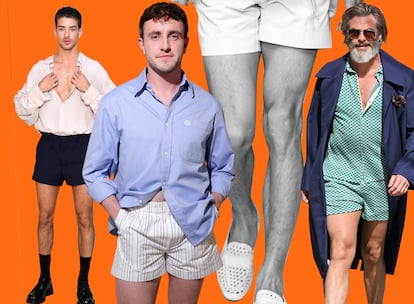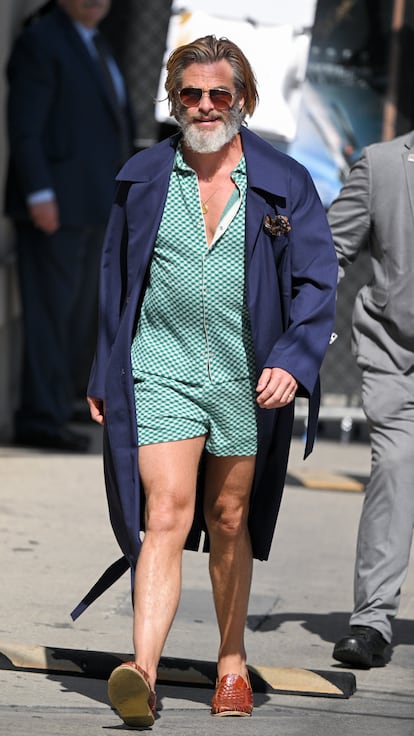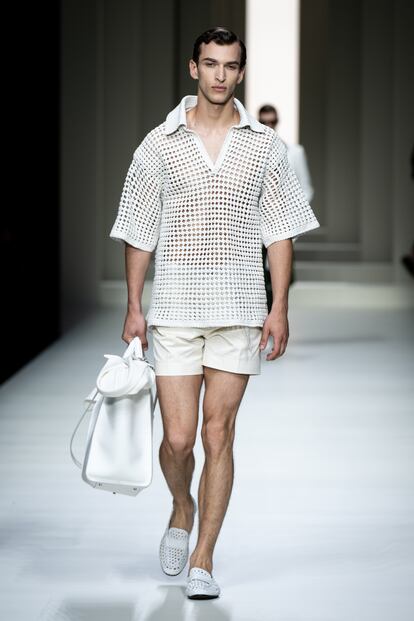‘Slutty Bermudas’: The menswear that has turned thighs into erotic capital
Global media has dubbed them ‘slutty shorts’ and not only Paul Mescal is donning them. Thanks to rising temperatures, fashion trends and the erotization of the male body, this summer, minimal leg covering is taking to the streets

It’s quite possible that your feeds have recently been overtaken by images of actor Paul Mescal dressed in a pair of very short striped shorts that could be mistaken for underwear, paired with a shirt and loafers more appropriate for one’s first dinner with future in-laws. The Irish actor has long been deserving of the title of short-shorts champion, but this latest appearance, which took place at a Gucci fashion show, has raised such a stir that it leaves no room for alternate hypothesis: as men’s magazines warned starting a few weeks ago, short-shorts or “slutty shorts” are an unavoidable reality.


It’s not only actors who have taken on the trend, though Mescal has been joined by Jeremy Allen White, Chris Pine, Milo Ventimiglia and Donald Glover, a pioneer for having set things off two years ago by refusing to wear a shirt (though he did sport a hat) with his tiny yellow shorts. The phenomenon can also be seen on the omnipresent digital influencers. On menswear runways — like those of Prada, Rick Owens, Dries Van Noten, Dolce & Gabbana and Gucci itself — there have been sightings of abbreviated Bermudas, at times seeming like an invocation of the spirit of the Italian Rivera, at others interspersed with other trends of the moment like tenniscore (a nod to garments designed for the court, following in the success of Luca Guadagino’s movie Challengers) and uses of classic men’s cotton boxers as streetwear. True too, sportswear brands and the giants of fast fashion have seen fit to capitalize on the style. This summer, there is no going back on short-shorts.
That being said, questions and a certain confusion can also be found in abundance. Though vocational fashionistas, fresh off their acceptance of the pirate pant, have readily turned to their scissors and gym memberships, gender role traditionalists have located in short-shorts fever yet more proof of the decline of the Western world. Calmer, perhaps more productive takes point to the sociological and cultural implications that can be found in the new exposure of the male thigh.


Although, to be fair, this trend is far from new. A historical review uncovers men of all social classes in ancient Egypt, Greece and Rome showing thigh and calf at will in clothes similar to today’s women’s skirts and dresses. From the 1950s on, the genre of Roman and gladiator films and its Italian sub-genre, peplum (the Latin word for a Greek garment), provides a fine account of this replete with a certain eroticism that, due to the morals of the time, could not say its name, but whose target audience — hello, homosexual men — received with enthusiasm. In the absence of other non-straight role models, several generations of gays got their sensual education from such movies, as authors like Terenci Moix have chronicled in memoirs.
Starting in the Middle Ages, and lasting for centuries, the skin of the adult male leg was stolen from public gaze, covered up with stockings, tights or long pants of various types. In the 19th century, save for certain regional wardrobes, pants worn above the knee were limited to use by young boys. It was not until the expansion of the European colonial empires in the 19th and 20th centuries — even the most abject enterprises have some positive consequences — that Bermuda shorts were invented, though they were initially reserved for tropical climates and only later popularized as a dignified way of coping with Western thermal peaks. Today, with temperatures rapidly climbing due to climate change, shorts are an essential element of the global north’s universal male wardrobe from June to September. But one might say, it was between the late 1970s and early 1980s that the shortest of them experienced their first, great moment of glory.

At the time, characterized by the expansive wave of the sexual revolution, it was hardly seen as strange for men ensconced in heteronormativity to show up in public wearing short-shorts that today, we would judge slutty. A paradigmatic example can be found in the character Magnum, who was played on the series Magnum P.I. by Tom Selleck from 1980 to 1988. There too were the stars of other popular series of the day like Starsky & Hutch, Dallas and Happy Days. Even an actor as far from queer coding as Harrison Ford was frequently photographed wearing mini-shorts as a form of relaxed streetwear. And a twenty-something John F. Kennedy Jr. reached early heights of star power during Labor Day 1980 in Cape Cod with the help of only three elements: a bushy mane, an animal tusk hanging on a chain around his neck and tiny, white-trimmed shorts. Admittedly, all of these examples hail from the United States, but the phenomenon was far from a national affair. We need only look at footage of European soccer games during the first half of the 1980s: the space between the hem of the shorts and the knees of the Spanish team’s 1982 World Cup uniform would likely be considered unseemly today, to say the least.


This fever for men’s thighs brings with it the certain novelty of fixing one’s attention on a body part that for a long time was invisible. Or even, frowned upon. Take, for example, the long reign of the skinny jean: in the narrow trouser market, a strong thigh was a liability. New too is the joy that men are nowadays finding in the cultivation and display of such muscular charms, free of any fear of being sexualized. Just check the long lines at the leg machines at today’s gyms. Short-shorts, historically associated with childhood, are the ideal garment for self-obsessed men-children. The idea of treating men like sexual objects no longer raises eyebrows, but rather enthusiasm (if not obliviousness) on the part of those involved.
It also makes sense in this post-Covid universe, in which working from home has become the norm, that clothes like the boxer, whose usage was previously restricted to domestic intimacy, have emerged in the public sphere.

Be it as it may, this summer you’re going to see many adductors in cities around the world, not to mention a lot of vastus medialis, vastus lateralis, rectus anterior and even, pectineus. What this means beyond high-temperature vacations is not entirely clear, but more somber conclusions may also be ventured: the last rise of the mini-short preceded the onset of the Reagan era and a new world order characterized by conservative governments, the Cold War and culture wars. It’s time to hope for the best, but prepare for the worst.
Sign up for our weekly newsletter to get more English-language news coverage from EL PAÍS USA Edition
Tu suscripción se está usando en otro dispositivo
¿Quieres añadir otro usuario a tu suscripción?
Si continúas leyendo en este dispositivo, no se podrá leer en el otro.
FlechaTu suscripción se está usando en otro dispositivo y solo puedes acceder a EL PAÍS desde un dispositivo a la vez.
Si quieres compartir tu cuenta, cambia tu suscripción a la modalidad Premium, así podrás añadir otro usuario. Cada uno accederá con su propia cuenta de email, lo que os permitirá personalizar vuestra experiencia en EL PAÍS.
¿Tienes una suscripción de empresa? Accede aquí para contratar más cuentas.
En el caso de no saber quién está usando tu cuenta, te recomendamos cambiar tu contraseña aquí.
Si decides continuar compartiendo tu cuenta, este mensaje se mostrará en tu dispositivo y en el de la otra persona que está usando tu cuenta de forma indefinida, afectando a tu experiencia de lectura. Puedes consultar aquí los términos y condiciones de la suscripción digital.
More information
Archived In
Últimas noticias
Families demand repatriation of bodies of Colombians who died in Ukraine: ‘This war is a slaughterhouse for foreigners’
James Cameron: ‘For the films I like to make to continue to exist, we have to find a way to make them cheaper’
Helen Levitt, the photographer who captured the theater of the everyday
The guardians of the meteorites of the Argentine Chaco
Most viewed
- Christian Louboutin: ‘Young people don’t want to be like their parents. And if their parents wear sneakers, they’re going to look for something else’
- US sanctions against jailed cartel leader ‘El Marro’ highlight Mexico’s lack of control over its prisons
- Cartels in Mexico take a leap forward with narco-drones: ‘It is criminal groups that are leading the innovation race’
- Liset Menéndez de la Prida, neuroscientist: ‘It’s not normal to constantly seek pleasure; it’s important to be bored, to be calm’
- ‘El Limones’ and the growing union disguise of Mexican organized crime











































